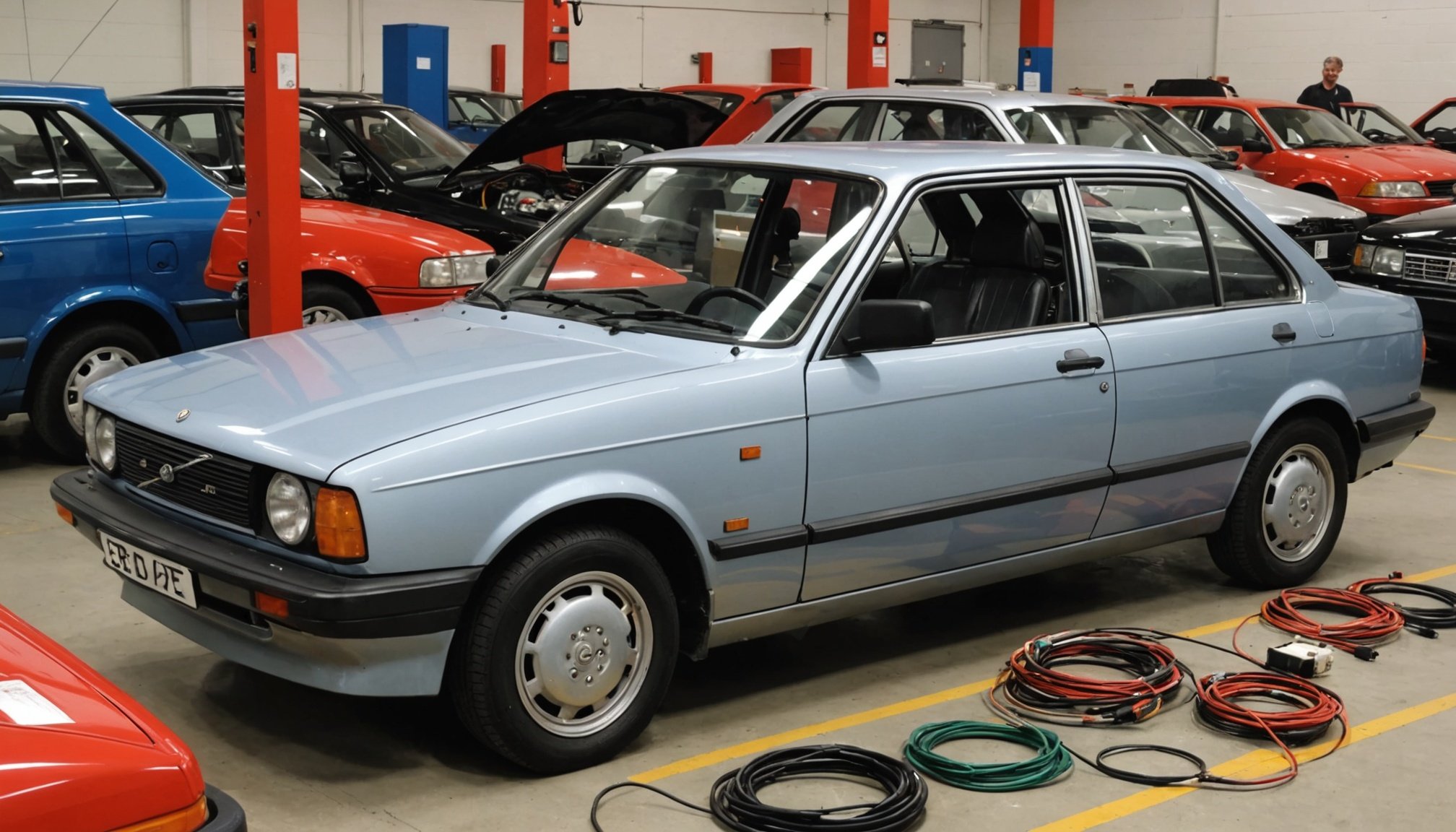Overview of Electrical Issues in 1990s British Cars
Navigating electrical problems in 1990s British cars was a common concern for owners. These vehicles often encountered issues ranging from faulty wiring to battery failures, affecting everyday functionality and reliability. Understanding the vehicle’s electrical system became crucial for maintenance and troubleshooting.
Common electrical problems included malfunctioning lights and intermittent issues with the ignition system. Often, the root causes lay within corroded connections or worn-out components, such as the alternator or starter motor. Frequent challenges also arose with the vehicle’s wiring, where age and wear would contribute to increased resistance or complete circuit failures, disrupting the vehicle’s performance.
Also to see : Unlocking torque testing techniques: the ultimate handbook for engine performance evaluation in uk vehicles
Several key components within these cars were prone to failure, especially when poorly understood. For instance, the complexity of the vehicle’s electrical system meant that common problems such as blown fuses or faulty relays were difficult to address without comprehensive knowledge. Being informed about typical components that may fail, like the alternator, starter motor, and wiring harnesses, enabled owners to proactively address issues and reduce the likelihood of sudden malfunctions.
Awareness and systematic diagnosis of electrical problems were therefore essential, helping owners mitigate issues and maintain the vehicle more efficiently.
This might interest you : Achieve perfect car alignment at home: a comprehensive diy guide for uk drivers with common tools
Tools and Equipment Needed
Working with electrical diagnostic tools and repair tools is essential for addressing electrical issues in 1990s British cars. Here’s what you need to effectively troubleshoot and fix common problems:
Essential Tools for Troubleshooting Electrical Issues
A set of standard hand tools, including screwdrivers, pliers, and socket sets, is crucial for any electrical work. For precision diagnostics, a digital multimeter is indispensable. It allows for accurate measurement of voltage, resistance, and current, which is vital for pinpointing issues such as faulty wiring or blown fuses.
Recommended Diagnostic Equipment and Multimeters
Investing in a reliable multimeter with features like auto-ranging and a continuity tester is highly recommended. Additionally, specialised scanners can help in diagnosing issues with the car’s onboard electronics. These tools make it easier to identify problems within complex electrical systems unique to British cars.
Safety Gear and Precautions During Electrical Work
Before embarking on any repairs, ensure you have the appropriate safety gear, such as insulated gloves and goggles. Always disconnect the battery to avoid electrical shocks. Working methodically and understanding the car’s wiring diagram can significantly minimise risks associated with electrical repairs.
Step-by-Step Troubleshooting Techniques
Troubleshooting electrical diagnostics in British cars from the 1990s requires a strategic approach. Begin with a comprehensive understanding of the troubleshooting procedures, which is vital for effective British car repairs. Checking fuses is the first step. Ensure all fuses related to the malfunctioning component are intact. A blown fuse often indicates a short circuit, which needs addressing before replacement.
Next, examine the wiring and grounds. Wires should be intact and connected; loose connections or corroded terminals are common sources of electrical issues. Use a multimeter to check for continuity and resistance, ensuring the circuits are complete. It’s also essential to scrutinise grounds—they can create various electrical complications if faulty.
Interpreting electrical diagrams specific to British cars is crucial. These diagrams provide a visual guide to the vehicle’s electrical layout, helping pinpoint problem areas. Familiarise yourself with the symbols and pathways shown; they can be invaluable when diagnosing problems unique to these vehicles. By methodically following these steps, one can efficiently navigate electrical diagnostics and repairs. Embracing this structured process enhances the likelihood of a successful fix, restoring the vehicle’s performance.
Common Electrical Problems by Component
Navigating electrical issues in 1990s British cars often means dealing with component-specific failures that can disrupt the vehicle’s functionality. Understanding these common problems and their solutions is essential for effective maintenance and repair.
Battery and Charging System
A frequent issue with these vehicles is the battery and charging system. Problems can include difficulty starting the car or dimming lights, often pointing to a faulty alternator or depleted battery. Regularly checking the battery for corrosion and ensuring the alternator is functioning optimally can prevent these issues.
Ignition System
The ignition system is another area prone to glitches, with symptoms like engine misfires or difficulty starting. These can result from worn-out spark plugs or faulty ignition coils. Addressing such problems involves replacing defective parts and ensuring all connections are secure.
Lighting and Wiring
Lastly, lighting and wiring problems can manifest as flickering headlights or malfunctioning signal lights. This often stems from deteriorating wiring or poor connections. Diagnosing these problems requires checking for broken wires and ensuring all connections are tight and free from corrosion, restoring reliable vehicle performance.
Safety Guidelines When Working on Electrical Systems
Ensuring electrical safety is paramount when tackling repairs on 1990s British cars. Proper precautions can prevent injuries and avoid potential hazards inherent in electrical repairs. Primarily, always disconnect the battery prior to any maintenance. This crucial action helps avoid electrical shocks and short circuits that may occur during repair work.
Understanding the potential hazards is also vital. Electrical wires often carry significant voltage, posing risks of shock or fire if mishandled. Make sure to work methodically and double-check connections before powering any component. Familiarity with the car’s electrical system can significantly reduce the risk of accidental mishaps.
Safety equipment is indispensable. Using insulated gloves and goggles offers protection against unexpected shocks or debris. Additionally, ensure your workspace is clean and devoid of moisture, which could exacerbate electrical risks.
Being cautious and knowledgeable about the vehicle’s electrical system will aid in safe and successful repairs. Following these steps is not only about ensuring personal safety but also about maintaining the integrity of the vehicle’s electrical components during repair work. Prioritising safety helps ensure both a secure working environment and a reliably functioning vehicle.
Repair Tips and Techniques
Taking on electrical repairs in 1990s British cars requires meticulous attention to detail and strategic methods. Here are some practical electrical repair tips to enhance the DIY solutions process.
Soldering and Wire Repairs
Achieving effective soldering starts with practising precision. Always ensure wires are stripped properly before soldering to guarantee a solid connection. A high-quality soldering iron with adjustable temperature settings is essential to prevent overheating components.
Safe Replacement of Electrical Components
Before replacing any electrical components, always secure a reliable power source. Identify and procure the exact replacement parts needed. Disconnect the negative terminal of the battery to eliminate risks during component swaps. Test the new components thoroughly to confirm their functionality.
Long-lasting Electrical Fixes
To ensure long-term reliability, verify all connections are secure and free of tension. Applying dielectric grease can help prevent corrosion in exposed terminals and improve conductivity. Additionally, regularly inspect repaired areas to detect any signs of degradation.
By embracing these techniques, enthusiasts can tackle repairs confidently and maintain the longevity and functionality of their vehicle’s complex electrical systems.
Additional Resources and References
Navigating the complexities of electrical issues in 1990s British cars can be challenging without the right resources. To deepen your understanding, several support resources offer comprehensive materials tailored to these vehicles.
Books and Manuals: Investing in detailed manuals and books specific to the electrical systems of 1990s British cars can be invaluable. These resources cover everything from basic troubleshooting to in-depth component analysis, providing essential support for both novices and seasoned hobbyists.
Online Forums and Communities: Engaging with online forums dedicated to British car maintenance provides quick solutions and shared experiences from fellow enthusiasts. User-contributed insights often include practical advice and step-by-step guides tailored to these vintage vehicles.
Parts Suppliers and Repair Services: Access to reputable parts suppliers ensures you can source quality replacements, vital for maintaining reliability. Consider partnering with established repair services specializing in British cars for tasks demanding professional expertise. They often have the necessary understanding of electrical systems unique to these autos.
By leveraging these support resources, owners can enrich their knowledge base, ensuring effective maintenance and timely repairs. This proactive approach encourages longevity and optimal performance of British cars from the 1990s.











